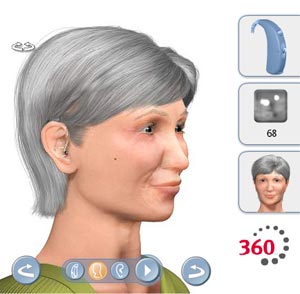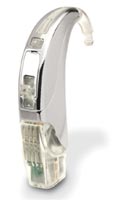Interview with Sarah Cerney, Au.D., Product Manager, Unitron Hearing US
Topic: Unitron 360
 CAROLYN SMAKA: Hello, this is Carolyn Smaka from AudiologyOnline. Today I'm speaking with Sarah Cerney from Unitron. Sarah, welcome to Audiology Online.
CAROLYN SMAKA: Hello, this is Carolyn Smaka from AudiologyOnline. Today I'm speaking with Sarah Cerney from Unitron. Sarah, welcome to Audiology Online.SARAH CERNEY: Thank you very much for having me.
SMAKA: Before we discuss the new 360™ products, Sarah, can you tell me about your background?
CERNEY: Sure. I am the Product Manager at Unitron Hearing U.S. I'm responsible for managing the introduction of new products into the U.S. market as well as managing existing products throughout their lifespan. I've been with Unitron for almost four years and in my current position for almost two years. I was previously a trainer and a member of the technical support team here at Unitron Hearing. Prior to that, I worked clinically for about seven years, which included dispensing hearing aids to all ages.
SMAKA: Thank you. Can you tell me about the development of 360?
CERNEY: Sure. Unitron Hearing has a long-standing reputation for manufacturing excellent behind-the-ear (BTE) instruments. We've had the US 80 PP for many years which has been a very successful analog super power instrument. We wanted to look at integrating some of our new innovative technologies into a digital super power instrument product family.
There are two different 360 models: 360+, which is a highly advanced instrument, and 360e, or 360 Essential, which is a more basic version.
SMAKA: What kind of gain and output are we talking about, and is that the same for both the 360+ and the 360e?
CERNEY: 360 provides 82 dB peak gain and 141 dB SPL peak output, and that's for both the 360+ and the 360e. You can't even begin to talk about being in this segment unless you're able to offer that amount of power.
SMAKA: That's definitely superpower. That sounds like one of the strongest on the market.
CERNEY: Yes, it's right up there in line with any of the other competitive products, however with the superior feedback management system and adaptive features tailored for the severe to profound loss, we like to refer to 360 as having more usable power.
SMAKA: And every dB counts for that market segment. What features do these products have?
CERNEY: When developing this product, we wanted to take a close look at some of the adaptive features and algorithms that could benefit this population. We also wanted to look at why some users may not be benefiting from automatic programs that have existed in the marketplace up to this point. So we took a very close look at optimizing some of the adaptive features that are available already to milder degrees of hearing loss, and tailoring those features specifically for users with severe to profound loss.
 We have a new version of speech enhancement called Speech Enhancement SP, which is tailored to severe to profound losses. Of course we've also included some of the other features that we've had in past products such as AntiShock™ and Noise Reduction. In addition, we've added a new Bass Enhancer for people who require increased output in low frequencies to boost loudness perception. And we also have our automatic program, or AutoPro2™, that has also been modified to provide automatic multiband adaptive directionality while still providing the power necessary to maintain environmental awareness.
We have a new version of speech enhancement called Speech Enhancement SP, which is tailored to severe to profound losses. Of course we've also included some of the other features that we've had in past products such as AntiShock™ and Noise Reduction. In addition, we've added a new Bass Enhancer for people who require increased output in low frequencies to boost loudness perception. And we also have our automatic program, or AutoPro2™, that has also been modified to provide automatic multiband adaptive directionality while still providing the power necessary to maintain environmental awareness. SMAKA: How does Speech Enhancement SP work?
CERNEY: There are actually three different components of Speech Enhancement SP. The first is level dependency. We've expanded the level dependency of our speech enhancement system so that it's active over a wider range of input levels, because average speech can be more difficult to hear for someone with a severe to profound loss than it is for people with milder degrees of loss. Level dependency allows for us to provide a greater boost for soft and average speech than is provided for loud speech. There's also loudness compensation, which is an automatic adjustment that helps to reduce the effect of noise while maintaining the additional boost for speech. The third component is a bandwidth control, so it's customizable as broadband or narrowband, depending on the configuration of the loss. At the maximum setting, speech enhancement SP will provide up to 8 dB of speech enhancement.
SMAKA: What feedback technology does 360 have? We know that feedback can sometimes be an issue when you're pushing this kind of gain and output.
CERNEY: We've carried forward our very successful phase canceller from the Yuu™ and Next™ product lines into 360. We have more usable power in 360 than what you'll get in competitive products, and that's a result of the gain and output that's available with 360 coupled with its great feedback management system. So it really does deliver more usable gain and output before the onset of feedback to the user.
SMAKA: Does Unitron have a special name for the feedback system? I didn't remember.
CERNEY: We just call it a phase canceller. We like to call things what they actually are.
SMAKA: That's refreshing;it makes it much easier when you're fitting the products.
Sarah, we know that many people with severe to profound hearing loss are experienced wearers of amplification, and have very specific preferences in how they want their hearing aids to sound. How are the features of 360 adjustable for the professional, in order to best satisfy wearers?
CERNEY: I totally agree that this market segment is generally very knowledgeable about what works for them and what doesn't. We certainly saw in our 360 field trials that some of these new adaptive features were accepted by previous analog users. Some subjects were able to detect that there were things changing at first in terms of automatic adjustments, however they adapted to them quite well. Within the U:fit™ software, professionals can configure the adaptive features for an individual user, turn any adaptive feature off, or slowly introduce an adaptive feature over time. That's part of the automatic program, too. Both destinations of AutoPro2 can be independently adjusted for frequency response and any of the adaptive features.
SMAKA: I would think that kind of flexibility would be very important. Is a new version of U:fit software required to fit this?
CERNEY: Yes, U:fit version 1.5 is required to fit 360.
SMAKA: Are there other new features in U:fit 1.5, in addition to being able to fit 360?
CERNEY: Yes, there's a new type of fitting wizard in U:fit 1.5 called fastTrack™, which allows for a more basic view that guides the fitter through the fitting process in five easy steps. It's available for all of the instruments that are programmed with U:fit. It's a new tool for professionals to get used to the software, and can be turned on or off at any time.
We're also introducing a pediatric mode in the software to facilitate pediatric fittings. There are options in the software to save your preferred fitting philosophy for pediatrics for two different age groups, 0-4 and 5-8. U:fit also offers DSL v. 5.0 for pediatric or adult fittings as well.
There is also a new digital hearing instrument style and color selector, called myStyle™, available in the software and also on our website. It's an interactive tool where you can select either a female or male model, and then you can choose the different colors and different styles of instruments and actually see what they'll look like in the ear.

myStyle™
SMAKA: It sounds like a great counseling tool.
You mentioned a new pediatric fitting mode and new features in the software for pediatrics. Is the 360 family appropriate for for pediatrics as well as adults?
CERNEY: Yes, it is definitely appropriate for pediatrics. In addition to having an easy-DAI program that can be activated in the software, being compatible with the integrated FM offered by Phonak, and having all the things necessary to feel confident in fitting it to a child such as tamper proofing, mini earhooks, etc., 360 has also been designed to be very durable and reliable.

Integrated FM
SMAKA: Really, how so?
CERNEY: We have given it our stamp of approval that we call Enviro-Tough™. We put it through rigorous testing and 360 withstood the testing, and demonstrated continuous performance despite being exposed to really harsh conditions. For example, a dust ingress lab test was performed where 360 was exposed to fine particle powder circulating for an eight hour period. The testing company then took the instrument apart afterwards to determine whether or not the powder penetrated the casing and reached any of the internal components. They have different levels of performance, and 360 received the highest test rating.
 And then we did lots of testing regarding protection against perspiration and repetitive strain tests were performed on all of the controls: the VC toggle switch, the program button, the battery door, and the earhook. This testing proved that 360 can stand up to real-life stressors and is resistant to impact, wear and tear, dust, debris, and perspiration.
And then we did lots of testing regarding protection against perspiration and repetitive strain tests were performed on all of the controls: the VC toggle switch, the program button, the battery door, and the earhook. This testing proved that 360 can stand up to real-life stressors and is resistant to impact, wear and tear, dust, debris, and perspiration.The whole case design is resistant to anything getting inside of it. It also has special microphone protection that is taken from marine industry technology. It's a very resistant membrane to sweat and oil and other things that could get inside of the microphone.
SMAKA: I would think reliability and durability are important because the people that wear superpower hearing aids are not the ones who wear them for two hours at the movies and then take them off. These are 16 hours a day, 7 days a week, 365 days a year wearers.
CERNEY: That's where the name 360 came from! We know that these people want to be able to wear their hearing aids and remain connected to their world regardless of what they are doing. Whether they are going out for a jog, or working in a humid environment, they need their hearing aids and rely on them, and we wanted to design an instrument that was very resistant to anything getting in the way of that.
SMAKA: You mentioned field trials. What kind of comments have you had from people wearing 360?
CERNEY: There have been very positive comments from the internal and external field trials. What's interesting is that there's a member of our corporate team in Kitchener that has a severe to profound hearing loss and she has been instrumental in giving input regarding this product.
She's part of the audiology team, and her background gives us a lot of insight because she's not only experiencing 360, but she's also developing it. She found 360 to be a great improvement over her previous instruments and was able to hear her small child in the back seat of the car without having to adjust her rearview mirror to see him talking. This was something she had never been able to do before.
SMAKA: Interesting! Sarah, when will 360 be available?
CERNEY: The product started shipping on November 3rd, so it's available now.
SMAKA: Good luck with the product launch and thank you for your time today.
CERNEY: Thank you for having me.
For more information about 360, visit www.unitronhearing.com, or the Unitron Web Channel on AudiologyOnline, www.audiologyonline.com/channels/unitron_hearing.asp

About Unitron
For 40 years, Unitron Hearing has been committed to bettering the lives of people with hearing loss by developing and manufacturing high-quality hearing instruments. This means a commitment to develop innovative hearing solutions to your everyday problems and concerns you have with hearing loss.
Unitron Hearing U.S. is an ISO registered custom manufacturing facility. Our team pays close attention to each individual order from the shell lab through assembly to final computerized quality testing.

